AMD Ryzen 7 7800X3D vs Intel Core i9-13900K vs Core i7-13700K: Big Gaming Punch, Smaller Price Tag
Zen 4X3D vs Raptor Lake.
The AMD Ryzen 7 7800X3D vs Intel Core i9-13900K vs Intel Core i7-13700K showdown is a matchup of one upper mid-range processor against two nimble and competent competitors for the title of the best CPU for gaming.
The $448 Ryzen 7 7800X3D is now the fastest gaming CPU in the world. The 7800X3D recently debuted to critical acclaim, arriving with eight cores and 16 threads and AMD's Second-Gen 3D V-Cache that deliver ever-so-slightly more gaming performance than the flagship $699 Ryzen 9 7950X3D. The 3D V-Cache tech fuses a 3D-stacked cache chiplet atop the processor to deliver market-leading gaming performance at the expense of performance in productivity applications, but while it delivers explosive uplift in some games, not all titles benefit.
In contrast, the $570 Core i9-13900K wields 24 cores and 32 threads with Intel's 13th-Gen Raptor Lake x86 hybrid architecture. The Intel Core i9-13900K is Intel's fastest gaming processor, and while it isn't quite as fast as AMD's X3D chips in gaming, it serves up a more predictable blend of performance in both gaming and productivity apps.
Intel also has its Core i7-13700K, which offers nearly the same level of performance as the 13900K in gaming, but at a much more amenable $417 price point that is more competitive with the Ryzen 7 7800X3D. While the 13700K isn't as fast in productivity work as the 13900K, it also offers far more performance than the 7800X3D in the types of apps.
This makes for a complex array of choices if you're looking for a flagship gaming experience with your next rig, and that's before we even factor in pricing. Below we've taken the Ryzen 7 7800X3D vs Core i9-13900K vs Core i7-13700K rivalry through a six-round faceoff to see which chips take the crown in our gaming and application benchmarks, along with other key criteria like power consumption and pricing. Let's see how they stack up.
Features and Specifications: AMD Ryzen 7 7800X3D vs Intel Core i9-13900K and Core i7-13700K
| Header Cell - Column 0 | Street/MSRP | Cores / Threads (P+E) | P-Core Base / Boost Clock (GHz) | E-Core Base / Boost Clock (GHz) | Cache (L2/L3) | TDP / PBP / MTP | Memory |
|---|---|---|---|---|---|---|---|
| Core i9-13900K / KF | $570 (K) - $554 (KF) | 24 / 32 (8+16) | 3.0 / 5.8 | 2.2 / 4.3 | 68MB (32+36) | 125W / 253W | DDR4-3200 / DDR5-5600 |
| Ryzen 7 7800X3D | $449 | 8 /16 | 4.2 / 5.0 | 104MB (8+96) | 120W / 162W | DDR5-5200 | |
| Core i7-13700K / KF | $417 (K) - $384 (KF) | 16 / 24 (8+8) | 3.4 / 5.4 | 2.5 / 4.2 | 54MB (24+30) | 125W / 253W | DDR4-3200 / DDR5-5600 |
AMD’s $449 Ryzen 7 7800X3D comes packing eight Zen 4 cores with the company’s second-gen 3D V-Cache tech that unlocks 96MB of total L3 cache. This combo delivers the fastest gaming performance available on the market. The 7800X3D has the same underlying design as the Ryzen 7 7700X with a central I/O die and one eight-core compute chiplet that provides a total of 8 cores and 16 threads.
Unlike the standard Ryzen 7000 chips, the 7800X3D's compute chiplet has an additional 3D-stacked L3 cache. However, this tech results in a lower boost clock of 5.0 GHz than the standard single compute chiplet models, which can reach up to 5.4 GHz. Despite the lower frequency, the cache-equipped chiplet provides the best gaming performance. In contrast, AMD's 7950X3D and 7900X3D come with two compute chiplets, requiring a new driver to steer threads for different types of workloads to the correct chiplet. In contrast, the 7800X3D is a plug-and-play processor that doesn't require special software.
The Ryzen 7 7800X3D has all the accommodations we expect from a modern chip, including DDR5, PCIe 5.0, and the latest USB standards. The chip also has an integrated graphics engine, but it isn't suitable for gaming. You can see our iGPU testing here.
The 7800X3D is incredibly power efficient, but AMD assigned a base TPD of 120W and a max 162W PPT, 15/20W higher than the 105W/142W rating for the standard 7700X. As you'll see in the power testing section, the higher TDP rating doesn't make much sense. Regardless, you'll still need to plan for a 240mm to 280mm AIO (or better) for the best performance.
The Ryzen 7 7800X3D requires an AM5 motherboard, so DDR5 memory is the only option. Unfortunately, DDR5 continues to carry a premium over DDR4 memory. Granted, that pricing pressure isn't as much of a consideration for the highest-end systems, but you should factor it in if you're struggling to cobble together a system in this price range. The AM5 platform is new, and the Ryzen 7000 chips aren't backward compatible with older AM4 motherboards. However, AMD will support the AM5 platform until 2025+.
The 7800X3D supports the auto-overclocking Precision Boost Overdrive (PBO), Curve Optimizer, and fabric and memory overclocking. Unfortunately, direct frequency overclocking isn't possible due to a voltage limitation for the 3D tech.
Intel's $589 sixteen-core Core i9-13900K comes with eight hyper-threaded P-cores and 16 single-threaded E-cores, for a total of 32 threads. That's an increase of eight additional E-cores over the previous-gen Core i9-12900K, equating to more threaded horsepower. You can also save some cash with the $564 Core i9-13900KF, which has identical specs but lacks the integrated GPU.
The P-cores come with a 3.0 GHz base, but, more importantly, a 5.8 GHz boost that's a whopping 600 MHz increase over the prior gen. Meanwhile, the E-cores now have a 3.0 GHz base (+600 MHz) and stretch up to 4.3 GHz (+400 MHz). The Core i9-13900K also has 32MB of L3 and 36MB of L2 cache.
The $417 Core i7-13700K comes with eight p-cores and eight e-cores, for a total of 16 cores and 24 threads. The reduced number of e-cores means this chip doesn't provide as much threaded horsepower as the 13900K, but its 5.4 / 2.4 GHz boost/base clocks keep performance snappy in latency-sensitive work, like gaming, while the e-cores are also effective in threaded work with a 4.2 / 2.5 GHz boost/base. 24MB of L2 and 30MB of L3 round out the package. You can also save some cash with the graphics-less $384 Core i7-13700KF.
The Raptor Lake chips use a newer revision of the 'Intel 7' node to push clock speeds higher while improving power efficiency. Intel's chips now have a Processor Base Power (PBP) value instead of a TDP metric, and a secondary Maximum Turbo Power (MTP) value that denotes the highest power level during boost activity. Be aware that modern Intel chips can always operate at the MTP when under load, though the actual power use will vary with application intensity. The 13900K and 13700K both come with 125W PBP (base) and 253W MTP (peak) power ratings, but in practice, the 13700K sucks less power.
The Raptor Lake chips support DDR4 or DDR5 memory, which can save you money on both the motherboard and memory. Both Raptor Lake chips drop into existing 600-series motherboards or the new 700-series models, but you'll need to ensure a 600-series board has the right BIOS or BIOS flashback. Intel allows full overclockability, but only when you pair the chips with a Z-series motherboard.
✅ Winner: Tie
The Core i9-13900K vs Ryzen 9 780X3D vs Core i7-13700K battle yields a tie in this category. All three chips support DDR5 and the PCIe 5.0 interface, meaning none have an inherent connectivity advantage.
Intel has the advantage of backward compatibility for DDR4 and the 600-series chipset, enabling lower-cost memory and motherboards for value seekers (caveats apply). Intel also has its Raptor Lake Refresh chips on the horizon, meaning there will be one more generation of upgrades for the LGA 1700 platform.
AMD's new AM5 platform generally carries a premium over the Intel motherboard ecosystem, but it does afford extended forward compatibility — AMD plans on supporting the AM5 platform until 2025+.
Given its new hybrid architecture with two types of cores, Intel's core counts aren't directly comparable to AMDs due to their different capabilities. Our performance results will dictate the performance value of the overall designs.
Gaming Benchmarks and Performance: AMD Ryzen 7 7800X3D vs Intel Core i9-13900K vs Core i7-13700K
Remember, this article is an overview of our much more in-depth testing in our AMD Ryzen 7 7800X3D Review. Below is the geometric mean of our gaming tests with the Core i7-13700K vs AMD Ryzen 7 7800X3D vs Intel Core i9-13900K at 1080p and 1440p, with each resolution split into its own chart. As usual, we're testing with an Nvidia GeForce RTX 4090 to reduce GPU-imposed bottlenecks as much as possible, but differences will shrink with lesser cards or higher resolutions.






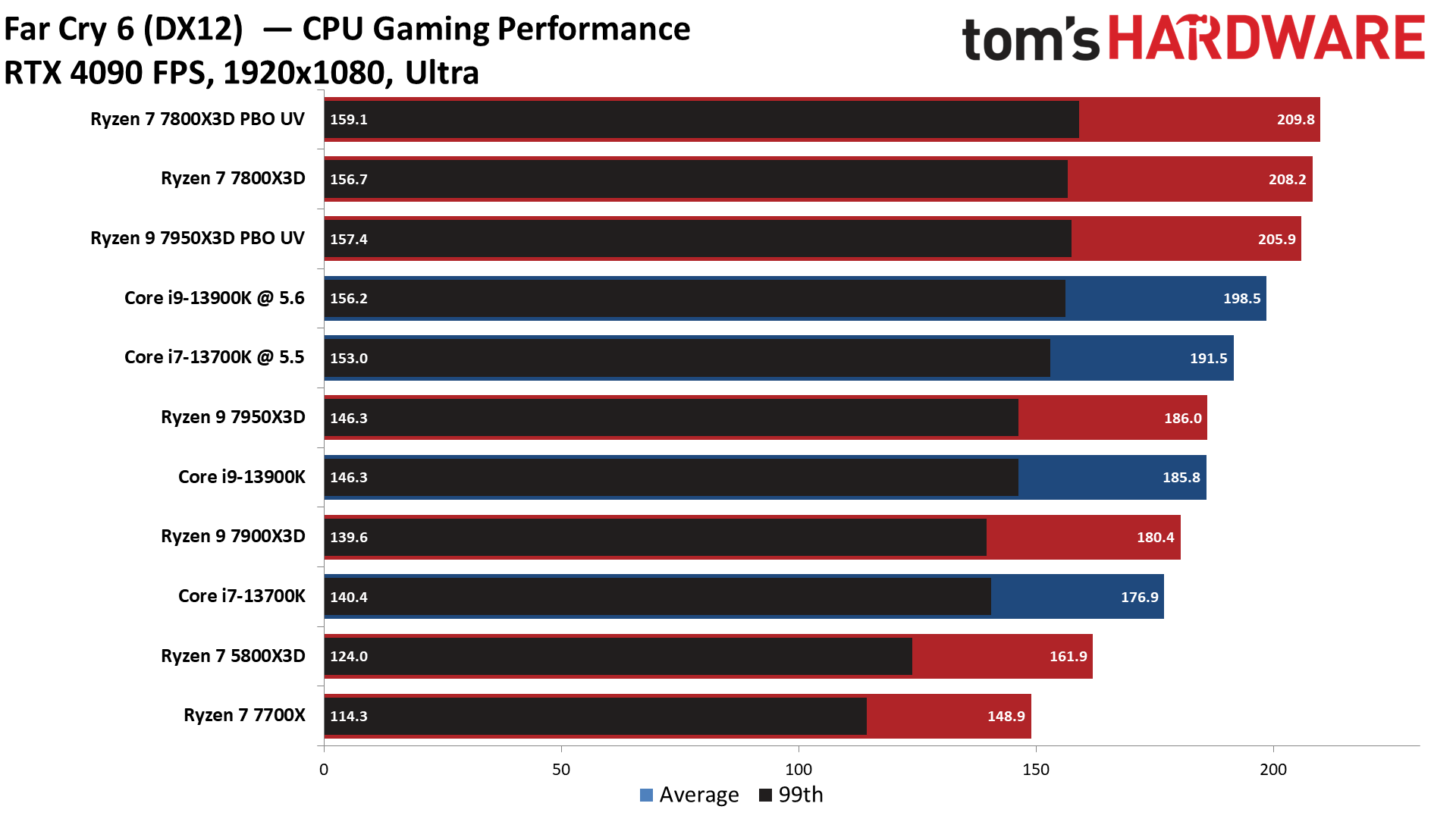


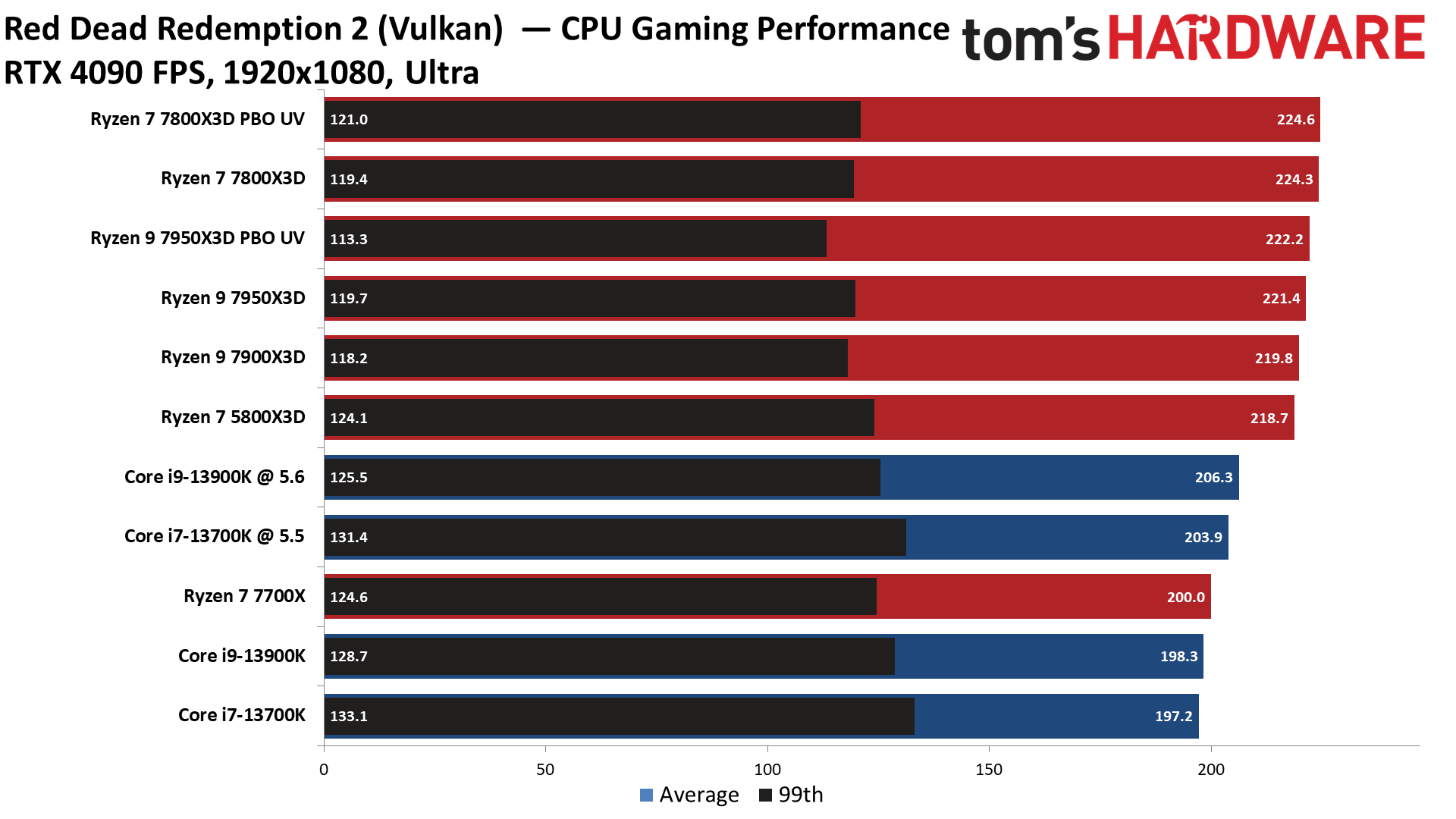








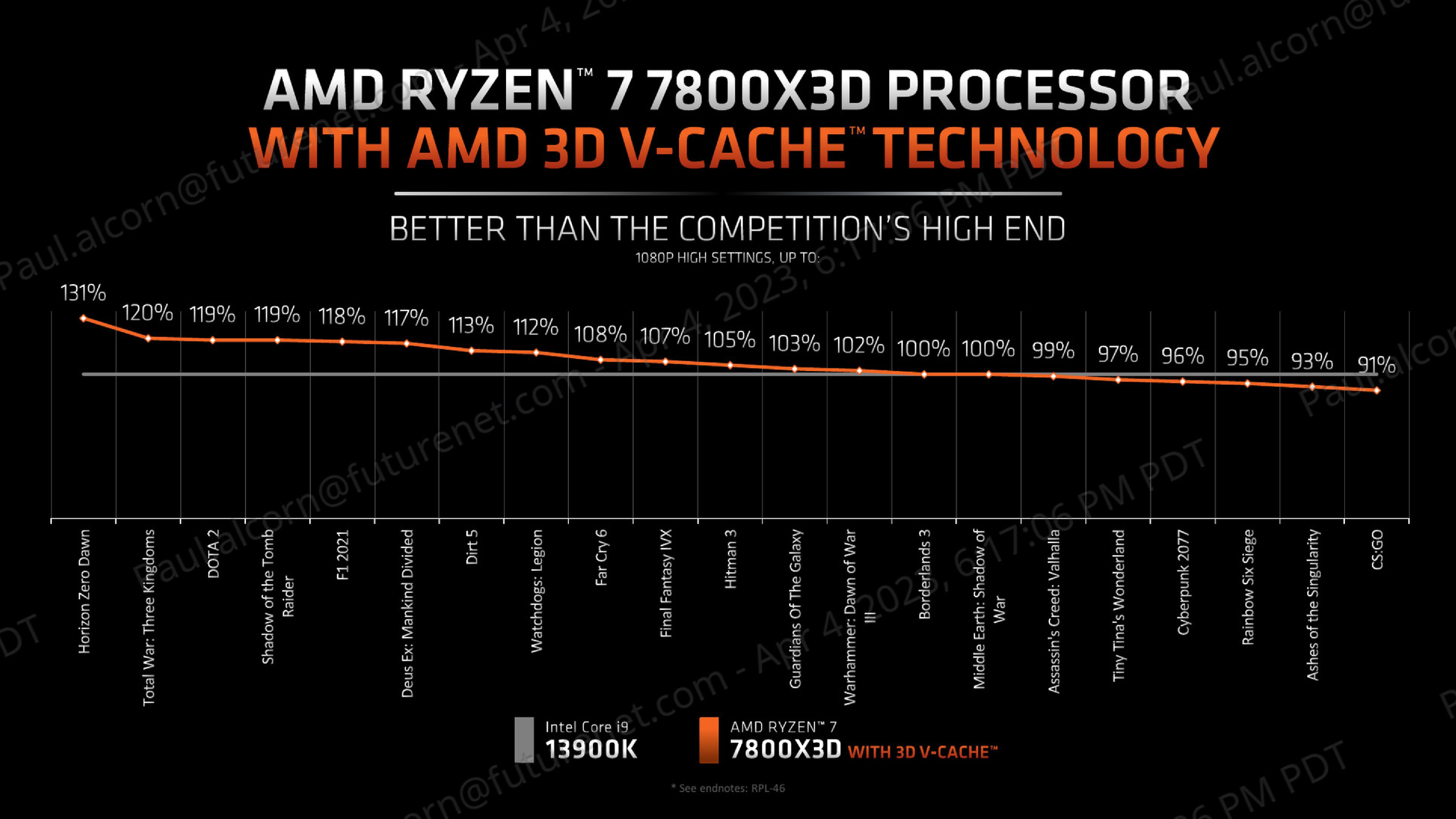

The 3D V-Cache tech puts AMD’s X3D chips in a league of their own in gaming, so the $449 7800X3D contends with the $699 16-core Ryzen 9 7950X3D for the lead — a victory it wins by a mere 1% in its stock config. The 7800X3D increases its lead over the 7950X3D to 2.5% at 1440p, but this is still a very close contest that falls into the imperceptible range. The price tag and number of cores is the biggest difference between these two chips; the 7950X3D costs $250 more and has twice the number of cores, which will help in productivity workloads.
The Ryzen 7 7800X3D is 12% faster in 1080p gaming than the $580 Core i9-13900K, and overclocking only narrows that to 8%. The Core i9-13900K requires exceptionally aggressive accommodations for overclocking. In contrast, the Ryzen 7 7800X3D never exceeded 90W in our testing. Overall, the 7800X3D will run faster and cooler than the 13900K in every gaming scenario, but the 13900K is far more potent in productivity-oriented tasks.
The $417 Core i7-13700K trails the 7800X3D by 14%, but it costs ~$30 less, and its more balanced performance in productivity apps makes it attractive if you're looking for a better all-rounder. The 13700K really takes the shine off the 13900K for gaming-focused rigs — the 13900K is only 1.5% faster in gaming but costs 39% more cash (an extra $163).
Moving over to 1440p pushes the bottleneck more towards the GPU, so the difference between the chips shrinks. For example, the Ryzen 7 7800X3D is 9% faster than the Core i9-13900K at 1440p with both stock and overclocked settings. It's logical to assume that most high-end gaming systems will use higher-resolution monitors, so the differences could be slight, but the 7800X3D will give you more headroom for future GPU upgrades.
As a reminder, the 3D V-Cache doesn’t accelerate all titles equally. Therefore, you should also look at the individual game benchmarks in the above album to assess the overall trend. As always, the AMD vs Intel competition can vary based on the title and the GPU you use, so it's best to make an informed decision based on the types of titles you play frequently.
Be aware that large deltas in individual game titles, as we see with the Ryzen 7 7800X3D, impact cumulative measurements. You can see examples of that in the above album in titles like Microsoft Flight Simulator 2021, Far Cry 6, and F1 2021. Our test suite heavily favors the improvements from 3D V-Cache, so we also included AMD’s own benchmarks in a broad range of games at the end of the above album to give you an idea of performance gains in other titles. As with all vendor-provided benchmarks, take AMD's slides with a grain of salt.
Get Tom's Hardware's best news and in-depth reviews, straight to your inbox.
✅ Winner: AMD Ryzen 7 7800X3D | All-Rounder Alternative — Core i7-13700K
It may be by the slimmest of margins over its own sibling, but on average, the Ryzen 7 7800X3D is the fastest gaming chip money can buy, dethroning the 7950X3D at a much friendlier price point. It is also much faster than both of the Intel contenders.
In our test suite, the Ryzen 7 7800X3D is 12% faster than the Core i9-13900K at 1080p gaming and 9% faster at 1440p. After overclocking, those deltas shrink to ~9% at 1080p and 1440p.
Ultimately, despite its lower-than-suggested pricing of $580, we can't give the 13900K the nod in this competition — instead, the Core i7-13700K gets an honorable mention. The 13700K delivers 98.5% of the 13900K's gaming performance despite the fact that the 13900K costs $163 more (39%).
The Ryzen 7 7800X is 14% faster than the 13700K, but you will pay higher up-front pricing to build a 7800X3D system. The 13700K is competitive with the 7800X3D in our system-level and fps-per-dollar pricing calculations below, leaving it as a competent alternative.
Productivity Performance: AMD Ryzen 7 7800X3D vs Intel Core i9-13900K vs Core i7-13700K

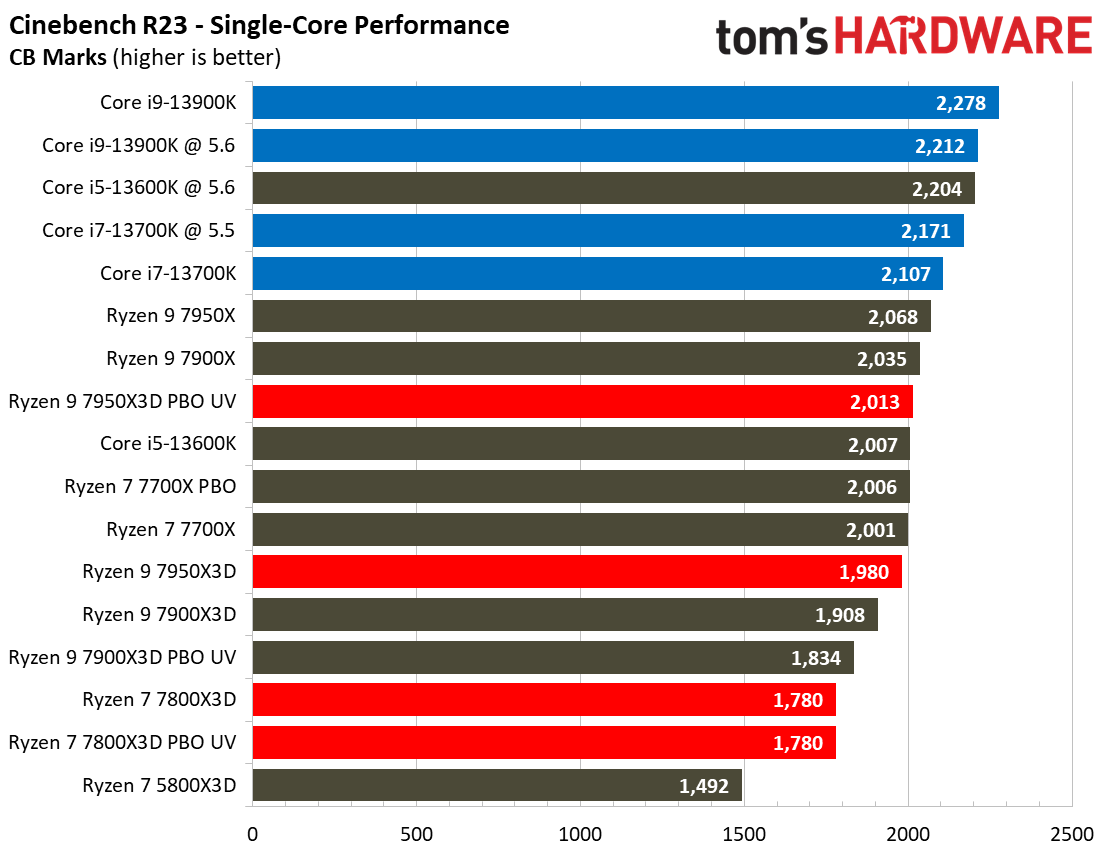



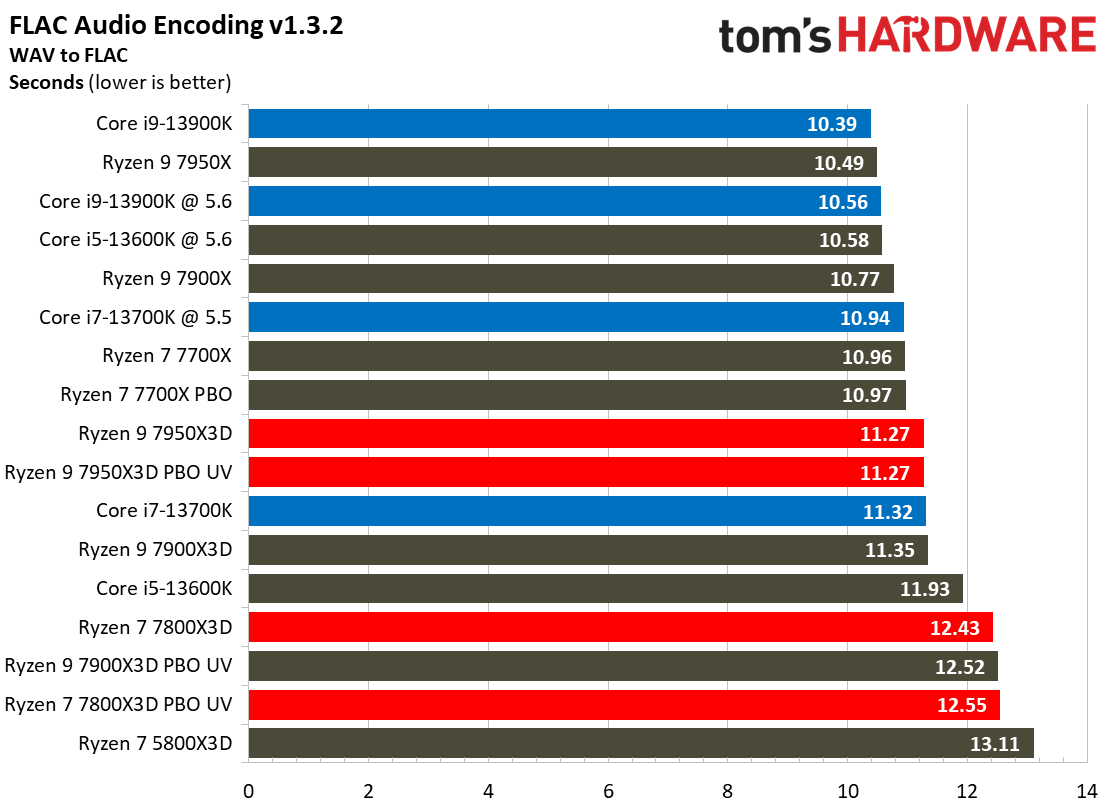


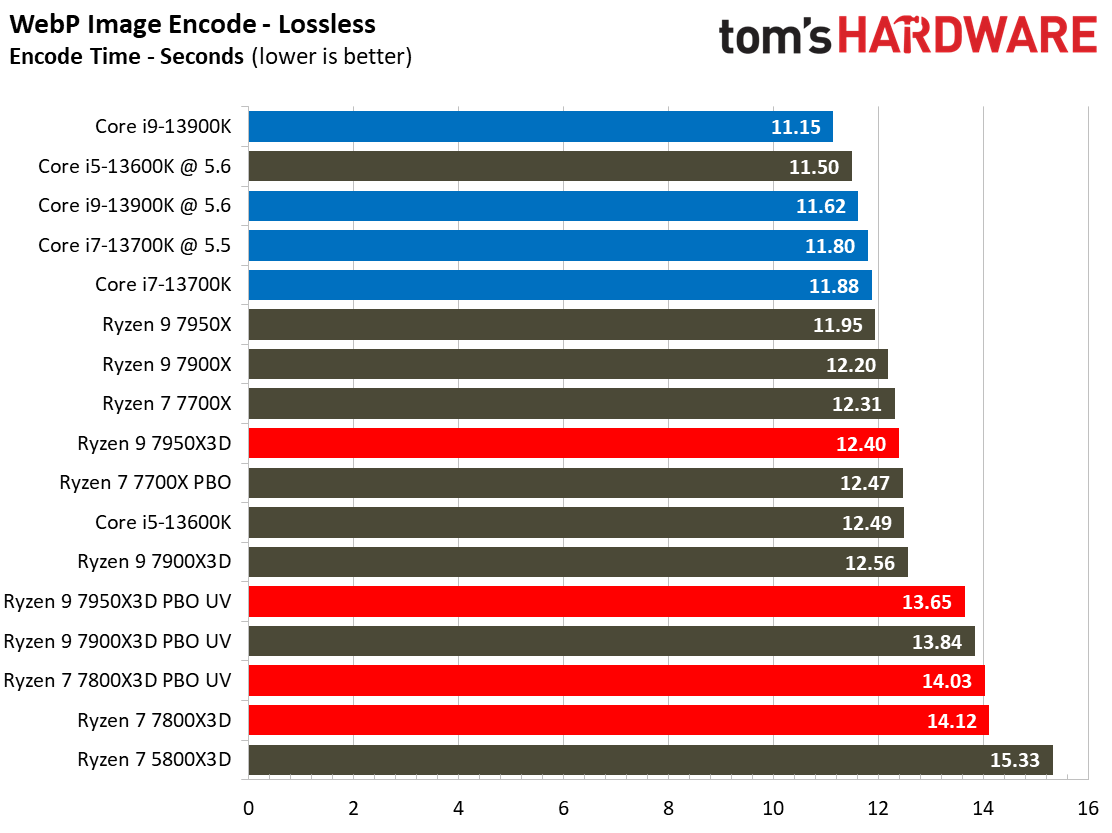


We can boil down performance in productivity apps into two broad categories: single- and multi-threaded. The first slide above shows the geometric mean of performance in several of our most important tests in the single-threaded category, but be sure to look at the expanded results in the above album.
The Core i9-13900K beats the 7800X3D easily: it's 32% faster in single-threaded work, while the Core i7-13700K is 22% faster. Naturally, those performance deltas won't carry over to every type of workload. However, flipping through the album of test results reveals that the Intel processors excel in single-threaded work, thus providing more responsive performance than the 7800X3D in light applications.
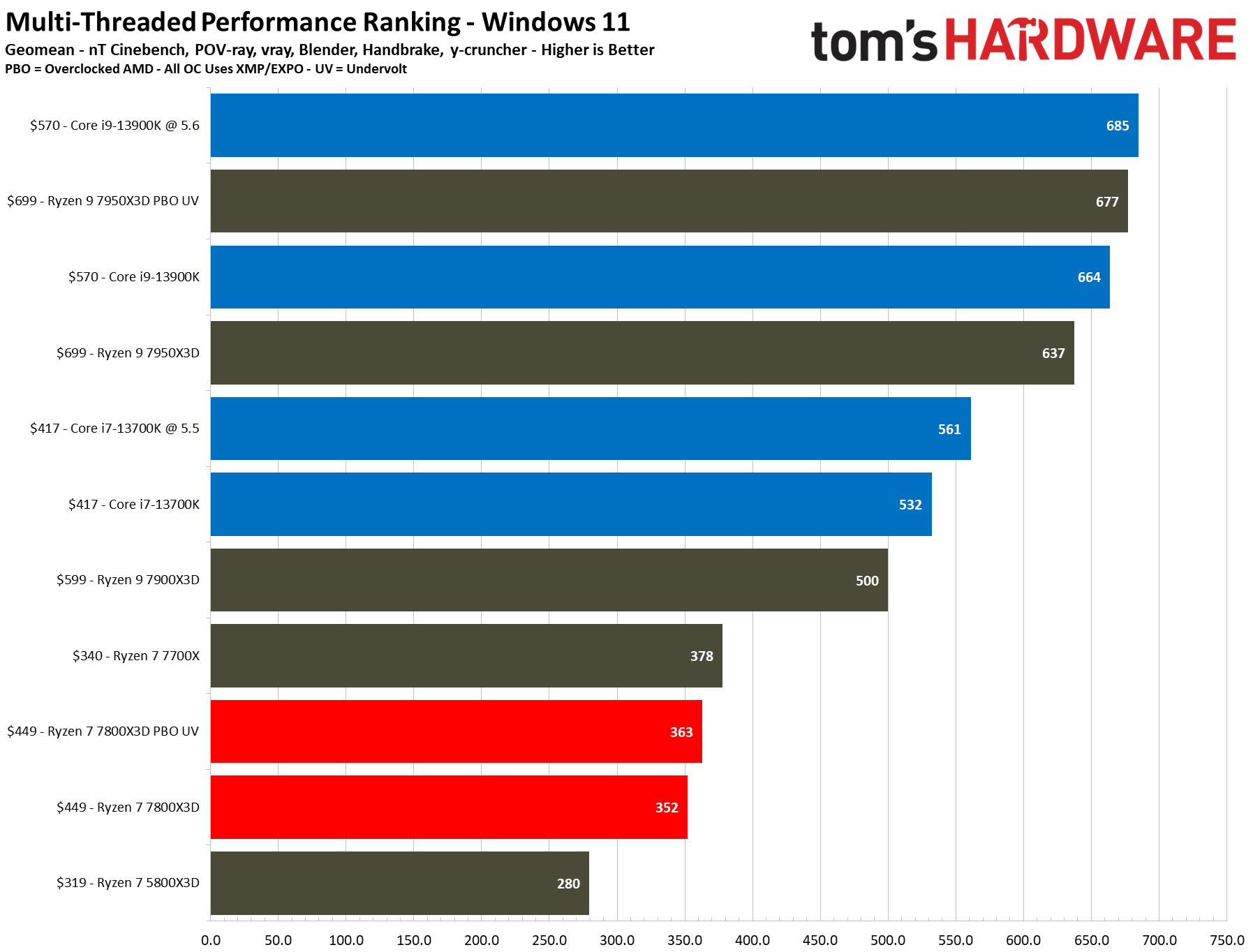



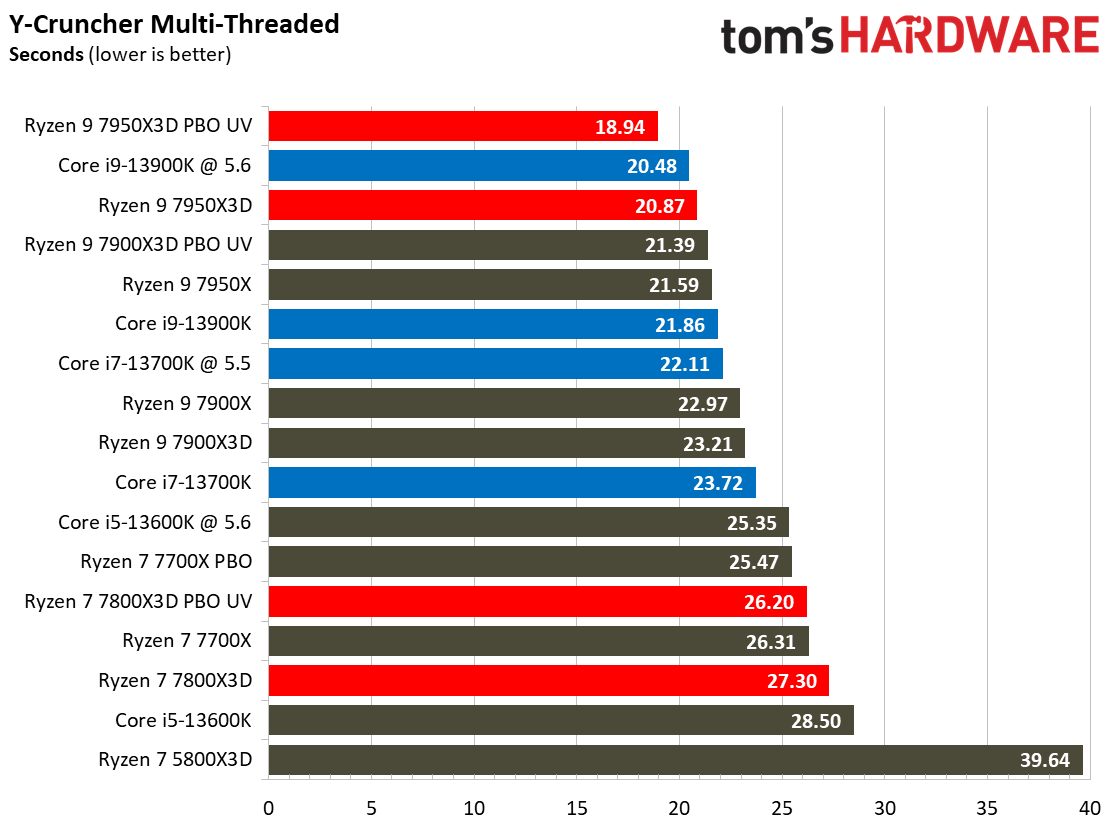



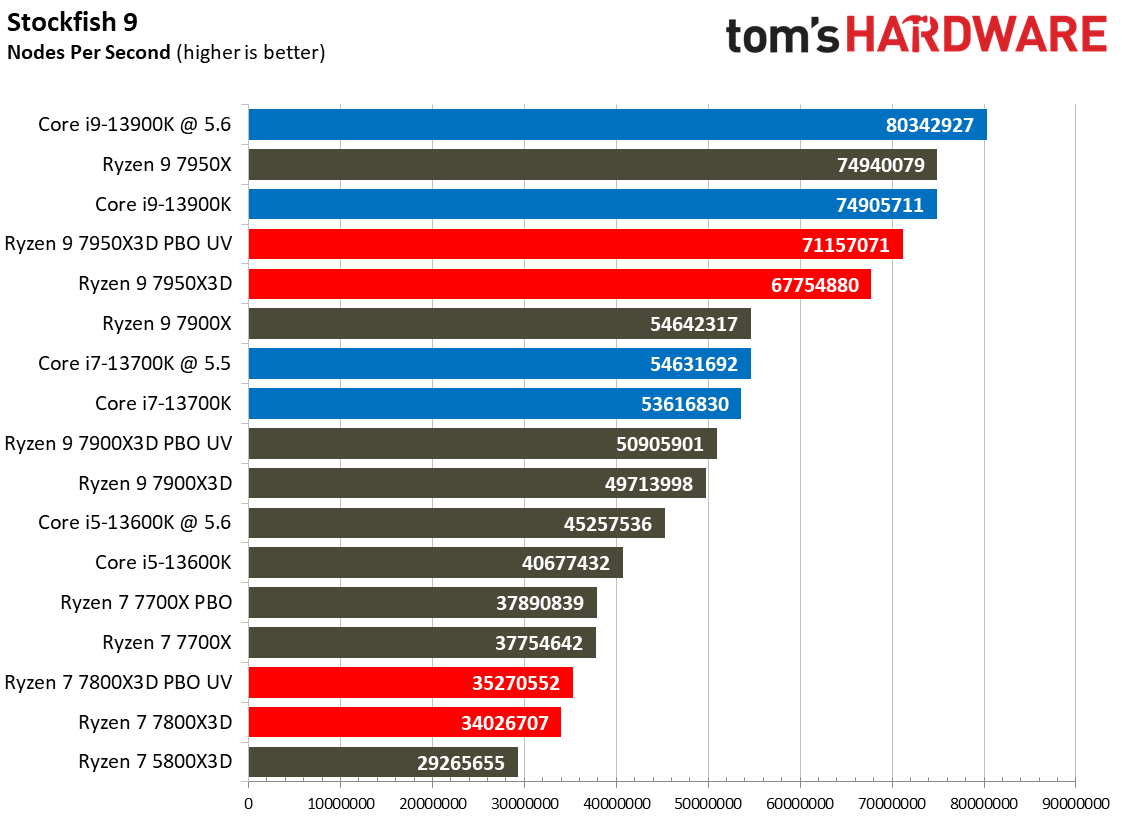






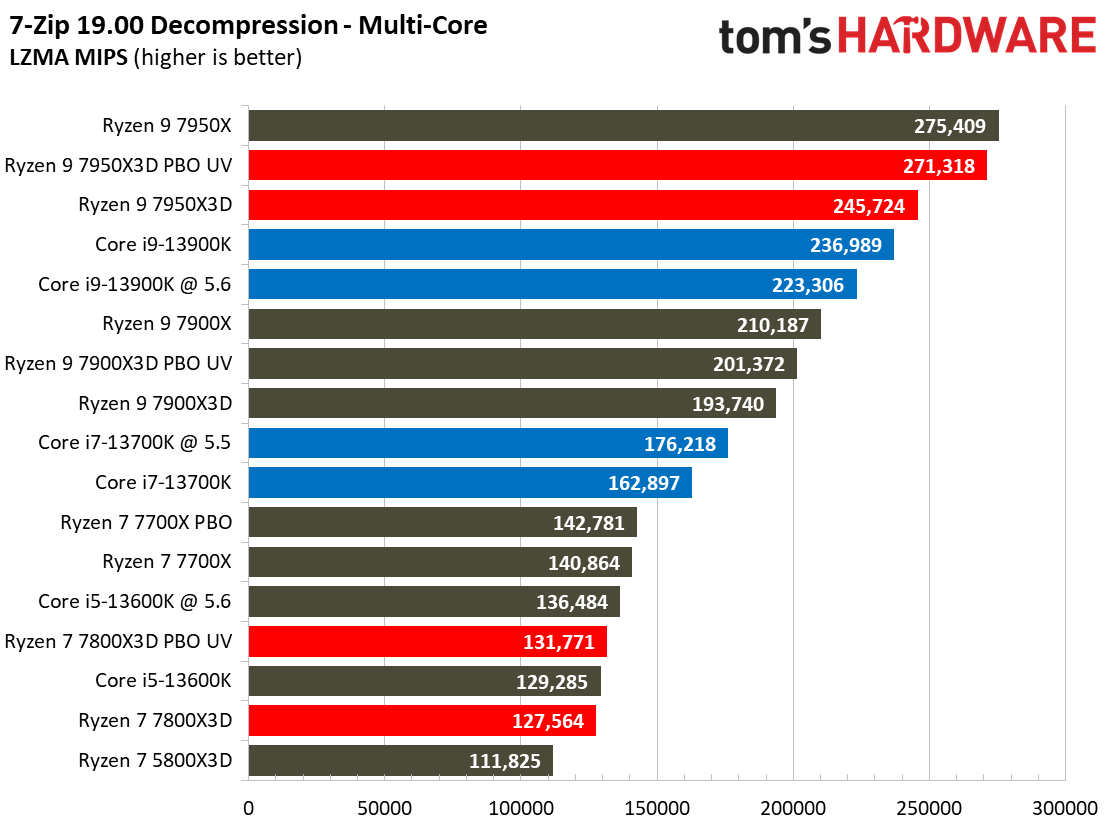
The first slide in the above album contains a geometric mean of performance in several of our multi-threaded benchmarks. In multi-threaded work, the $580 Core i9-13900K is a whopping 89% faster than the $449 Ryzen 7 7800X3D at stock settings, while the $417 Core i7-13700K is 51% faster. That's an easy win for the Intel chips.
✅ Winner: Intel Core i9-13900K and Core i7-13700K
The Core i9-13900K and 13700K have a more balanced profile in both single- and multi-threaded productivity applications than the 7800X3D, delivering solid performance in both disciplines. In contrast, the Ryzen 7 7800X3D suffers mightily in these workloads compared to the Intel silicon, highlighting that this is truly a highly specialized chip for gaming that won't offer as much performance in standard workloads as the regular Ryzen 7000 processors.
The implication here is clear — if performance in productivity workloads is important to you, select the Intel processor that best matches your needs in terms of both performance and pricing. The Ryzen 7 7800X3D is specifically designed for gaming-centric rigs, so you should steer clear if productivity apps are a big part of your daily usage.
Overclocking: AMD Ryzen 7 7800X3D vs Intel Core i7-13700K vs Core i9-13900K
We have long since reached the land of diminishing returns for overclocking the highest-end chips from AMD and Intel, like the Ryzen 9 and Core i9 families. Because AMD has pulled Intel into a dogfight for performance superiority on the high end, much of the overclocking frequency headroom is rolled into standard stock performance. However, there are still at least some gains to be had, and both Intel and AMD expose tunable parameters and sophisticated software overclocking utilities, like Intel's XTU and AMD's Ryzen Master.
Like the rest of AMD's new X3D chips, the Ryzen 7 7800X3D doesn't support overclocking via the CPU multiplier, so you can't change the core clocks or voltages directly. However, AMD now allows changing the power limits (PPT, TDC, EDC) through the auto-overclocking Precision Boost Overdrive (PBO) feature, and you can also now undervolt with the Curve Optimizer. These features weren’t supported on the previous-gen models. You’ll find plenty of examples of PBO+UV performance in our Ryzen 7 7800X3D review. As before, you can overclock the memory and fabric, too, though we've seen limited gains with the 7800X3D from these approaches.
Meanwhile, the Intel Core i9-13900K and Core i7-13700K expose every knob possible for tweaking and tuning. However, the 13900K's aggressive out-of-the-box power and Adaptive Boost Technology already consume most of the overclocking headroom you could achieve with conventional cooling. The 13700K leaves slightly more room than the 13900K for manual tuning due to its less-aggressive tech, but you shouldn't expect massive improvements. Sub-zero overclockers with exotic cooling solutions can reach much higher with the Intel chips than the 7800X3D, but that isn't as valuable to the overwhelming majority of users.
| Overclocking %age gain over stock | AMD Ryzen 7 7800X3D PBO UV | Intel Core i9-13900K @ 5.6 | Intel Core i7-13700K @ 5.5 |
| Gaming (1080p) | +3.1% | +6% | +4% |
| Single-Threaded | 1% | -2.5% | +3.2% |
| Multi-Threaded | +3.1% | +3% | +5.5% |
As usual, performance gains from overclocking can boil down to your luck in the silicon lottery. As you can see above, overclocking with conventional cooling for both the Intel and AMD processors results in fairly minimal gains in applications. In fact, the 13900K actually suffers from lower performance in single-threaded work because its 5.6 GHz overclock is lower than its stock 5.8 GHz boost. The Core i9-13900K does gain 6% in gaming, a higher percentage gain than the 13700K and 7800X3D, but it still lags behind the 7800X3D's peak gaming performance.
✅ Winner: Tie
The payoff for overclocking is extremely limited with today's high end chips. Still, both platforms have plenty of knobs for enthusiasts, their respective overclocking advantages, and a suite of auto-overclocking and software utilities. Of course, dedicated tuners could find larger performance boosts by overclocking the core, fabric, and memory more aggressively than we have, but bear in mind that you're always at the whims of the silicon lottery when it comes to overclocking.
AMD's 3D V-Cache technology prevents direct voltage and frequency manipulations, but AMD has unlocked memory, fabric, Precision Boost Overdrive, and undervolting via the Curve Optimizer, all of which combine to provide plenty of avenues for boosting performance via various tuning techniques. In fact, the 7800X3D often delivers a similar amount of performance uplift as the Core i9-13900K, showing the value of its somewhat unconventional approaches. Additionally, some motherboard vendors, like MSI, have baked in new tuned overclocking profiles directly into the motherboard firmware, promising up to a 10% improvement in performance. But, again, your mileage will vary.
Meanwhile, Intel offers more overclocking functionality and the highest peak frequencies from direct tuning. However, much of that capability is already exposed right out of the box via the company's aggressive boosting technologies and sky-high power limits, thus reducing its value to casual overclockers.
Power Consumption, Efficiency, and Cooling: Intel Core i7-13700K vs AMD Ryzen 7 7800X3D vs Core i9-13900K

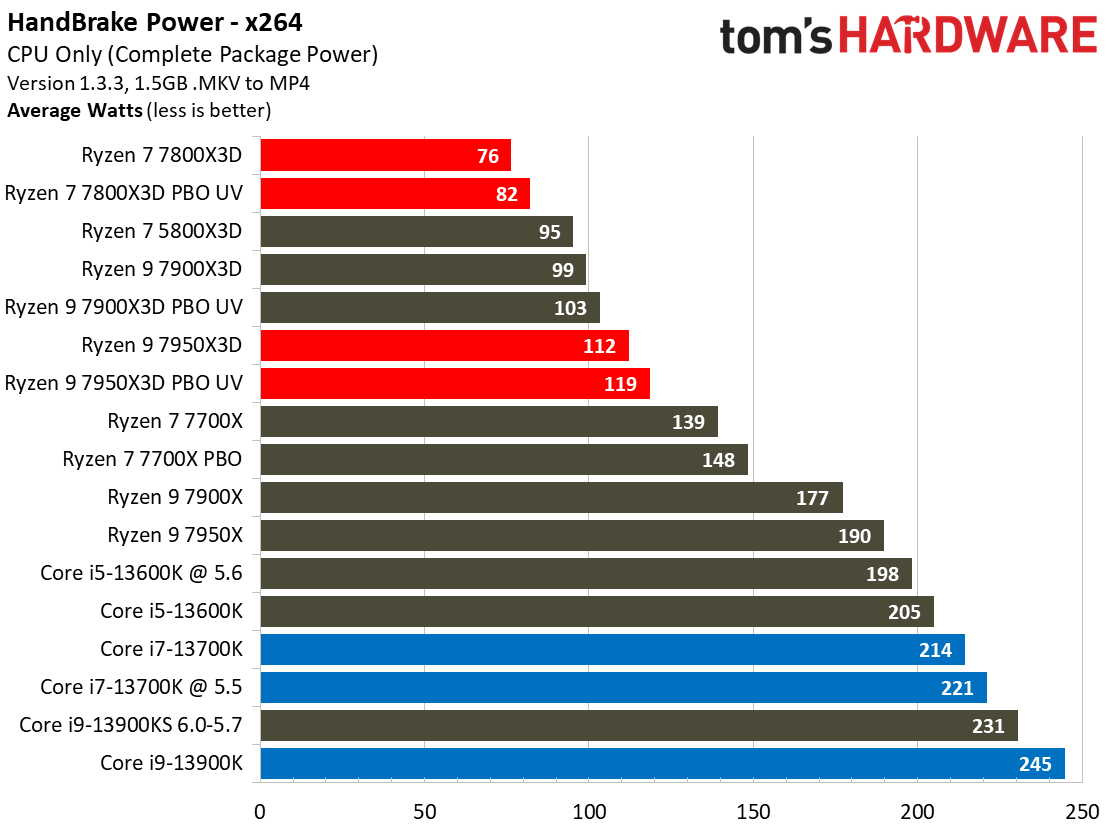


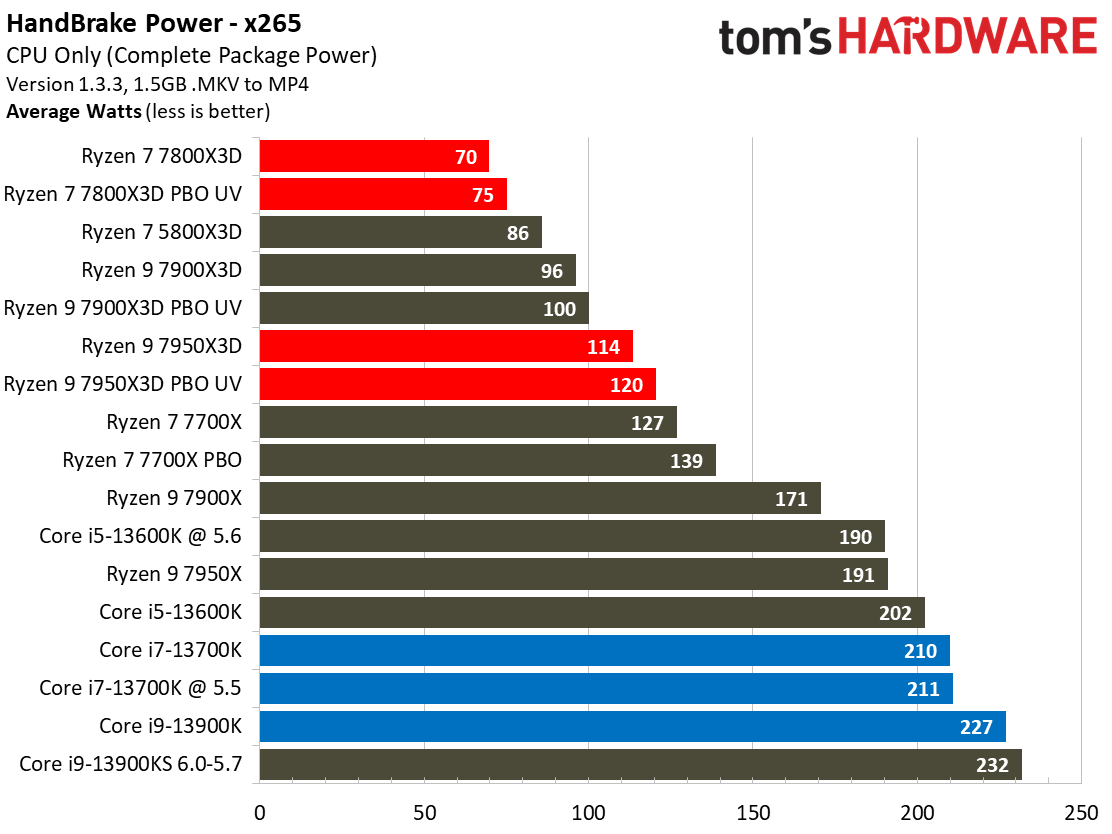
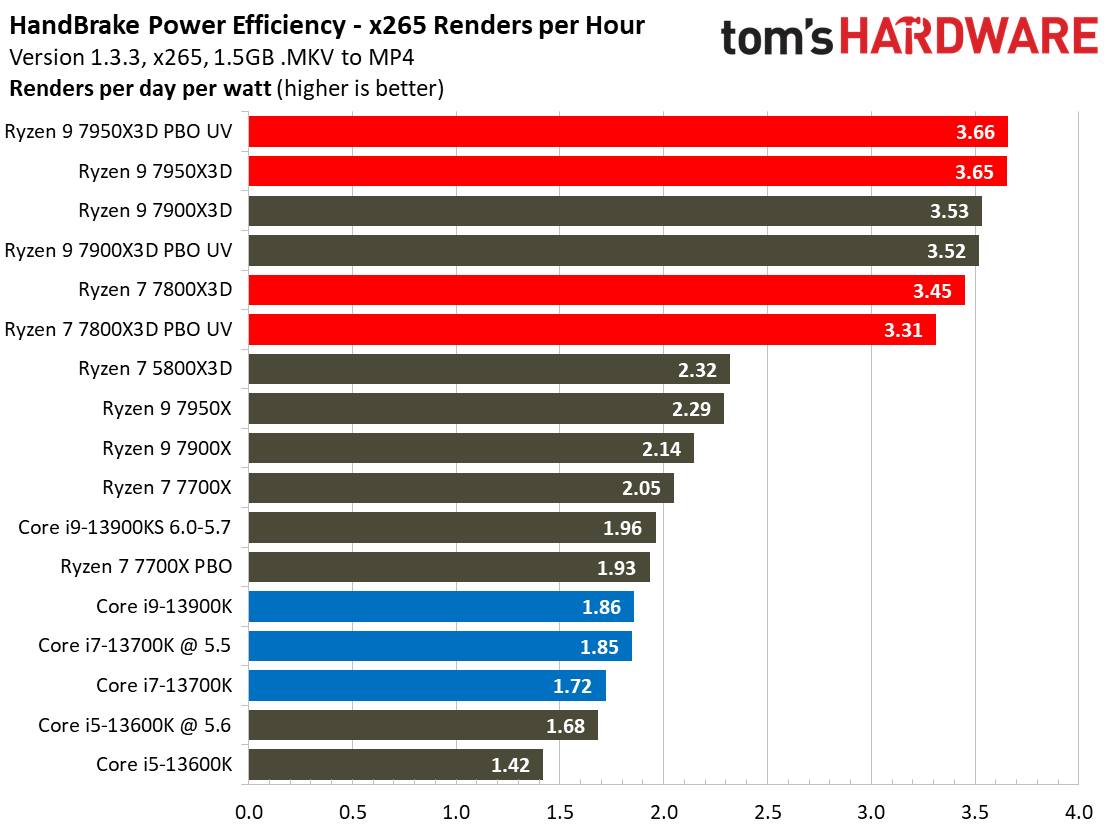







The Ryzen 7 7800X3D is incredibly power efficient, drawing far less power than the competing Core i9-13900K or 13700K, thus delivering superb power efficiency that ranks among the best we’ve ever tested. A quick glance at the HandBrake renders-per-day-per-watt metric shows that the efficiency competition isn't even close — the 7800X3D is the hand's down winner.
In fact, the Ryzen 7 7800X3D appears to fall into the standard 65W profile that specs a maximum of 88W of power consumption (PPT). AMD has spec'd a higher 120W TDP rating for the 7800X3D, but it appears to be running closer to the 65W TDP envelope during normal use — given our measurements, the Ryzen 7 7800X3D's 120W TDP rating seems far overprovisioned. This means the chip is basically operating in Eco Mode, which confers massive power consumption and efficiency benefits.
In contrast, Intel's chips consume far more power in every type of workload, resulting in higher thermal output.
✅ Winner: Ryzen 7 7800X3D
Intel has reduced its power consumption metrics, but the Ryzen 7 7800X3D is still far more power efficient. The 7800X3D consumes much less peak power and also delivers more work per unit of power consumed. That results in a win in power consumption, efficiency, and thermal output, ultimately giving you a cooler and quieter system.
None of these chips comes with a bundled cooler, but Intel's higher power consumption means you'll need more aggressive, and thus more expensive, cooling to extract the peak performance. In contrast, we don't think most users will have problems cooling the Ryzen 7 7800X3D with the recommended 280mm or greater cooler.
Pricing: Intel Core i9-13900K vs AMD Ryzen 7 7800X3D vs Core i7-13700K
| Tom's Hardware - Lower is Better | Dollars-per-fps — Chip Only | Dollars-per-fps — Chip, board, 32GB memory | Total System Cost |
| AMD Ryzen 7 7800X3D | $2.00 | $2.97 (B650) — $3.57 (X670) | $666 (B650) — $799 (X670) |
| Intel Core i9-13900K (Z790) | $2.90 | $4.27 (DDR4) — $4.30 (DDR5) | $819 (DDR4) — $860 (DDR5) |
| Intel Core i7-13700K (Z790) | $2.11 | $3.47 (DDR4) — $3.54 (DDR5) | $656 (DDR4) — $697 (DDR5) |
| Intel Core i7-13700K (B760) | $2.11 | $3.21 (DDR4) — $3.28 (DDR5) | $607 (DDR4) — $647 (DDR5) |
Tallying up the pricing numbers to compare the Core i7-13700K vs Ryzen 7 7800X3D vs Core i9-13900K can get incredibly complex once we start factoring in different classes of motherboards, so we included as much information as possible (links in the text below).
The Ryzen 7 7800X3D stands out as the fastest gaming chip money can buy and as the best gaming value in this price range. At $2.00 per frame, the 7800X3D is a far better value than the 13900K, which works out to $2.90 per frame. Of course, the Core i7-13700K is slower than the 7800X3D, but it is within striking distance in our value calculation at $2.11 per frame.
As you can see when we calculate the total platform cost above, plenty of other cost factors are in play, like memory and motherboards. In the end, provided you ensure it has adequate power delivery (which is easy for the 7800X3D), you can drop the 7800X3D into a B650 board and pay $2.97 per frame. That's the best value of the potential configurations. The 13700K with DDR4 memory on a B760 motherboard is close at $3.21 per frame, but it still lags slightly at $3.21.
Surprisingly, after equipping both chips with DDR5, we basically have a tie with the 13700K on a Z790 board and the 7800X3D on an X670. The Core i9-13900K simply isn't worth the cash if you're aiming solely for gaming, but it has its own attractions on the productivity side.
We used both the B650 and X670 chipsets for modeling the Ryzen 7 7800X3D's total system price, and tallied different price points based on DDR4, DDR5, Z790, and B760 motherboards for the Intel processors. Note that we didn't include a B760/13900K combo because that doesn't make sense with that class of chip, and you'll need to be careful to ensure adequate VRMs when pairing the 13700K with a B760 board. You also can't overclock the cores with a B-series board. Finally, we reduced the fps value for the Intel chips by 4% for the DDR4 calculations, as our testing shows that to be the average performance loss with the higher-end chips from stepping back from DDR5. You will retain the full performance in productivity applications, though.
The graphics-less $551 Core i9-13900KF saves you $30, and the $392 Core i7-13700KF saves you $25. We did not include those reductions in our calculations. The Core i9-13900K and 13700K are also compatible with previous-gen motherboards if they have the right BIOS, and performance will be the same between 600- and 700-series if the power delivery is identical.
AMD's X670/E motherboards currently start at roughly $80 more than Intel's Z790, but AMD B650 boards start at $126. However, you'll only find a single B650 board for around $130, while seven Intel B760 boards are either at or below $130. This is due to the lower pricing for Intel's DDR4-equipped motherboards; we've priced those differences into our full-system measurements.
Memory pricing is also tricky. DDR4 memory isn't an option with the AM5 platform that houses the 7800X3D, and while the deltas between DDR5 and DDR4 are becoming smaller over time, they still exist: You'll pay ~$60 bucks at a minimum for 32GB of DDR4, but pricing starts at $90 for 32GB of DDR5. That gap increases with higher capacities — it's $100 for the least expensive 64GB DDR4 kit but $195 for a 64GB DDR5 kit. That's nearly twice the price. How much weight you should give to the difference in memory pricing will be impacted by the speed and capacity of the kit you select. Additionally, perhaps the best memory kit is the one you don’t have to buy — many upgraders likely already have a DDR4 kit, which is something to consider if you have a kit on hand.
✅ Winner: Ryzen 7 7800X3D and Core i7-13700K
The Ryzen 7 7800X3D has a lower price tag than the $580 Core i9-13900K, but much higher performance in games. Overall, the 7800X3D has a commanding lead in both raw and system-level fps-per-dollar metrics, thus giving it the nod in the pricing department.
The Core i9-13900K is a superior offering if you're interested in performance in productivity applications. Still, the Core i7-13700K offers the lion's share of the 13900K's performance at a lower price point. In gaming, the Core i7-13700K offers similar raw and system-level pricing to the 7800X3D when you factor in the fps-per-dollar, thus also earning it a win in the pricing category.
The higher cost of AMD's motherboards generally adds more cost to your build than Intel's platforms, and the price premium for DDR5 also continues to add cost: At higher capacities, you'll pay nearly twice as much for DDR5 memory as DDR4 memory, and DDR5 is a strict requirement for AMD's 7800X3D.
However, the Ryzen 7 7800X3D has the performance lead in gaming by a large enough margin that it holds the lead in terms of overall value for builds focused strictly on gaming, an advantage that is most apparent against the 13900K. Additionally, the 7800X3D is the fastest gaming chip on the market, a privilege that most are typically willing to pay a premium for, yet it still beats the more value-centric 13700K, albeit by smaller margins, in our pricing efficiency metrics.
Bottom Line: AMD Ryzen 7 7800X3D vs Intel Core i9-13900K vs Core i7-13700K






| Row 0 - Cell 0 | AMD Ryzen 7 7800X3D | Intel Core i9-13900K | Intel Core i7-13700K |
| Features and Specifications | X | X | X |
| Gaming | X | Row 2 - Cell 2 | X - All-Rounder Alternative |
| Productivity Applications | Row 3 - Cell 1 | X | X |
| Overclocking | X | X | X |
| Power Consumption, Efficiency, and Cooling | X | Row 5 - Cell 2 | Row 5 - Cell 3 |
| Pricing | X | X | X |
| Total | 5 | 3 | 5 |
We have two separate battles in this contest: The Ryzen 7 7800X3D vs Core i7-13700K ends in a tie, with both chips getting the nod in five categories. Meanwhile, the Ryzen 7 7800X3D vs Core i9-13900K matchup tallies up to a 5-to-3 advantage in the 7800X3D's favor.
For gaming-centric rigs, the Core i9-13900K doesn't offer enough gaming performance to justify its price premium over the 7800X3D, and its other deficiencies in pricing and power consumption hurt its broader overall score. However, the 13900K vs 7800X3D contest isn't as much of a blowout win as the score implies. In the end, both of these processors have their own distinct advantages and disadvantages depending on your target use case.
If you're concerned about building a gaming-focused rig and everything else is a secondary concern, the Ryzen 7 7800X3D is by far the superior chip over the 13900K in terms of both outright performance and value. However, the Core i9-13900K is a better option than the 7800X3D if you use productivity applications frequently, and ensuring the highest level of performance is paramount. You should also consider that AMD has both the Ryzen 9 7950X3D and Ryzen 97900X3D on offer, both of which offer more cores for the productivity minded while maintaining 13900K-beating levels of gaming performance. Just be prepared to pay for the privilege of faster gaming performance.
When it comes to competing in gaming, the 13900K's biggest foe comes in the form of the Core i7-13700K — the 13900K is only 1.5% faster in gaming but costs 39% more cash (an extra $163). That makes the 13700K the obvious Intel pick for gaming-focused rigs. Additionally, although the 7800X3D beats the 13700K by 14% in gaming, the 13700K is competitive in terms of both raw and system-level fps-per-dollar pricing metrics, though you might have to make a few reasonable tradeoffs.
The Ryzen 7 7800X3D beats the 13700K by 14% in gaming but suffers from much lower performance than the standard Ryzen 7000 models in productivity applications, so you'll need to be aware of the tradeoffs. If you're looking for strong gaming performance paired with the ability to cut through heavier workloads, the Intel Core i7-13700K is a solid all-rounder at $417. For instance, the 13700K is 22% faster in single-threaded and 51% faster in multi-threaded work than the 7800X3D, and you can opt for the graphics-less $390 13700KF to save some extra cash.
AMD's 3D V-Cache tech doesn't accelerate all games evenly, so the lead could vary depending on your gaming selection. In either case, the Ryzen 7 7800X3D is the current gaming champ, and it often isn't a close contest. That's especially true in some game titles, like Microsoft Flight Simulator 2021 and F1 2021. The chip also drops into AM5 motherboards that support the latest connectivity tech, like PCIe 5.0 and DDR5, and AMD plans to support the platform until 2025+. In contrast, Intel’s current round of motherboards will only support one more generation of chips, so upgradeability remains an advantage for AMD.
The 7800X3D also holds the advantage in all power consumption metrics, including peak power and efficiency, ranking among the best we’ve ever tested. That results in more forgiving cooling requirements and a cooler and quieter system. On the other end of the spectrum, overclocking is becoming increasingly less interesting on the high end for most enthusiasts — you'll get a better payoff in the mid-range and low-end of the market. The Intel and AMD processors all provide at least some uplift after overclocking, making that contest a wash.
Given AMD's history of lower-than-MSRP pricing several months after launch, we think the Ryzen 7 7800X3D will eventually become another great chip for value seekers, particularly as platform-level costs continue to recede. If you're after an all-rounder, the Core i7-13700K is the better choice. If you're after the fastest gaming chip on the market, the Ryzen 7 7800X3D offers a lower-cost pathway to the very best that AMD's 3D V-Cache has to offer than you'll pay with the Ryzen 9 X3D chips. If you're willing to accept the tradeoffs, the Ryzen 7 7800X3D is the fastest gaming chip money can buy, earning a leading spot on our list of the best CPUs for gaming.
- MORE: AMD vs Intel
- MORE: Zen 4 Ryzen 7000 All We Know
- MORE: 13th-Gen Intel Raptor Lake All We Know
| Intel Socket 1700 DDR5 (Z790) | Core i9-13900KS, Core i9-13900K, Core i7-13700K |
| Motherboard | MSI MPG Z790 Carbon WiFi |
| RAM | G.Skill Trident Z5 RGB DDR5-6800 - Stock: DDR5-5600 | OC: XMP DDR5-6800 |
| AMD Socket AM5 (X670E) | Ryzen 7 7800X3D, Ryzen 9 7950X3D, 7900X3D, 7950X, 7900X, Ryzen 7 7700X |
| Motherboard | ASRock X670E Taichi |
| RAM | G.Skill Trident Z5 Neo DDR5-6000 - Stock: DDR5-5200 | OC/PBO: DDR5-6000 |
| AMD Socket AM4 (X570) | Ryzen 9 5800X3D, 5800X, 5950X |
| Motherboard | MSI MEG X570 Godlike |
| RAM | 2x 8GB Trident Z Royal DDR4-3600 - Stock: DDR4-3200 | OC/PBO: DDR4-3800 |
| All Systems | 2TB Sabrent Rocket 4 Plus, Silverstone ST1100-TI, Open Benchtable, Arctic MX-4 TIM, Windows 11 Pro |
| Gaming GPU | Asus RTX 4090 ROG Strix OC |
| Application GPU | Nvidia GeForce RTX 2080 Ti FE |
| Cooling | Corsair H150i, Stock Cooler |
| Overclocking note | All configurations with overclocked memory also have tuned core frequencies and/or lifted power limits. |

Paul Alcorn is the Editor-in-Chief for Tom's Hardware US. He also writes news and reviews on CPUs, storage, and enterprise hardware.
-
Avro Arrow One could also say that it has a much smaller carbon footprint. :giggle:Reply
Knowing that this was coming was the reason that I said the Ryzen 9 X3D CPUs shouldn't even exist and that not having a Ryzen 5 7600X3D was a serious mistake.
I am curious about one thing though, why is it being compared to two Intel CPUs? Like, what, you're going to throw everything that Intel has at it to maximise the number of Intel wins?
Hell, if you're going to do that, you may as well also throw in the R9-7900X3D because it's about the same price as the i9-13900K. -
SyCoREAPER IMO. The 13900K is not worth it for gaming over the 13700K. It runs multiple suns hotter and eats up more power for minimal performance gains.Reply -
pacdrum_88 I'm not sure how the 13700K ties 7800X3D in gaming. 14% less performance on average, and slightly less expensive. That's a pretty large delta. Also, everytime the 7800 wins in gaming, there's a caveat that Intel is better at productivity. If we're measuring gaming, let's measure gaming. If we're measuring productivity, let's measure productivity. If you want the best of both worlds, get the 7950X3D. Article feels like an Intel defense, not a comparison.Reply
" AMD is a faster gaming chip, competitively priced, on a new platform with lots of longevity, and is far more efficient. Also, Intel ties it... for some reason."
The results did not match up with the outcome. -
SyCoREAPER Reply
Because all those graphs explain it pretty clearly that AMD does win out on average, the 99% it does not, so it's a wash.pacdrum_88 said:I'm not sure how the 13700K ties 7800X3D in gaming. 14% less performance on average, and slightly less expensive. That's a pretty large delta. Also, everytime the 7800 wins in gaming, there's a caveat that Intel is better at productivity. If we're measuring gaming, let's measure gaming. If we're measuring productivity, let's measure productivity. If you want the best of both worlds, get the 7950X3D. Article feels like an Intel defense, not a comparison.
" AMD is a faster gaming chip, competitively priced, on a new platform with lots of longevity, and is far more efficient. Also, Intel ties it... for some reason."
The results did not match up with the outcome.
Same way cars work, you have city, you have highway ans you have combined. Two cars can have the same combined thus tie despite one edging the other In a respective test. -
Wow what a Intel Schill article, the 7800x3d is game centric sold by AMD as such, neither Intel or any other AMD chip can touch the 7800x3d in GAMES that is what its designed for and it beats the Intel top of the range chip for roughly half the power and heat output.....yet the 13700 ties?Reply
Intels up to its old tricks again with its "marketing" budget it seems -
-Fran- The 7950X3D should have been added as well and it would have taken all me metrics by storm xDReply
Regards. -
javiindo Happy that there were not redundant sections like node technology and efficiency which are directly related.Reply -
lmcnabney So the stock 7800X3D outperforms stock 13700K by 15% in gaming and you call it a tie in the gaming metric.Reply
Looks like Intel's thumb is on the scale. -
TerryLaze Reply
Like, don't you people even read, at all?lmcnabney said:So the stock 7800X3D outperforms stock 13700K by 15% in gaming and you call it a tie in the gaming metric.
Looks like Intel's thumb is on the scale.
They compare the 9 7800X3D to the Intel Core i9-13900K and the Ryzen 9 7950X3D and in that comparison the 7800x3d wins out against the i9-13900K and the Ryzen 9 7950X3D, but also so does the 13700k.
They don't call it a tie, they say that both these CPUs win...against the bigger ones.
We put the AMD Ryzen 9 7800X3D, the Intel Core i9-13900K, and the Ryzen 9 7950X3D through a six-round fight to see which chip comes out on top.
